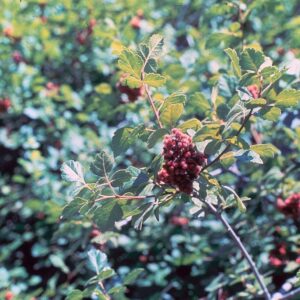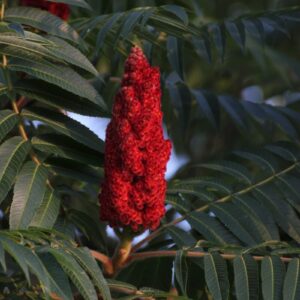Wholesale Sumac Shrubs in Michigan
Cold Stream Farm is a retail and wholesale supplier of Sumac Shrubs. From our farmland in Free Soil Michigan, we grow, package, and ship Sumac seedlings and transplants anywhere in the United States with no minimum order requirements. Some plants may only be available in the spring season, so please plan accordingly.
What is a Sumac Shrub?
Sumacs, also occasionally spelled as “sumachs,” are a group of flowering plants in the genus Rhus. All Sumac plants are small trees or deciduous shrubs, typically bearing dense, spike-like flowers in a variety of colors. Cold Stream Farm carries two species of sumac: Staghorn Sumac (Rhus typhina), and Fragrant Sumac (Rhus aromatica).
About Staghorn Sumac (Rhus typhina)
Staghorn Sumac, also known as velvet sumac or hairy sumac is an attractive flowering plant native to parts of the northeastern United States and southeastern Canada. The plant has been cultivated around the world for its bright colors and many uses. Click here to see our current availability of Staghorn Sumac (Rhus typhina).
About Fragrant Sumac (Rhus aromatica)
Secondly, Cold Stream Farm is proud to carry fragrant sumac, which is also called aromatic sumac. Despite looking a lot like its poisonous relative Toxicodendron radicans, Fragrant Sumac bushes are not harmful, but rather emit a nice fragrance when the leaves are crushed.
Learn more and check our available stock of Fragrant Sumac (Rhus aromatica).
Ideal Growing Conditions for Sumac Shrubs
In general, most sumac plants are very adaptable to a wide variety of growing conditions. Fragrant Sumac can be found in every single contiguous state in America, whereas Staghorn Sumac has been cultivated for global use.
Sumacs are very drought tolerant and able to withstand long dry spells that would easily destroy other species. Soils do not need to be nutrient-rich and the plants may actually help improve poor soil conditions. It is common to find sumac shrubs growing on exposed hillsides, rock faces, lawns, gardens, and wastelands. The shrubs prefer full sunlight conditions but can also tolerate partial shade.
Size of a Sumac Shrub
A Staghorn Sumac (Rhus typhina) plant may mature to reach up to 15 feet in height, whereas a Fragrant Sumac (Rhus aromatica) shrub will likely only grow to be 6 feet tall. Fragrant Sumacs are also more likely to be cultivated using “low-grow” techniques, as the plant can spread well horizontally with intentional pruning and care.
Leaves, Flowers, and Fruits
Sumac bushes are not evergreen, but rather have bright green leaves that turn into an orange-red hue in the fall. Flowers for both Fragrant and Staghorn species are yellow, emerging in the early spring. Meanwhile, the fruit of a Sumac shrub is bright red. A Fragrant Sumac has berry-shaped fruit in clusters, whereas a Staghorn Sumac is easily recognizable by its compact cone-shaped fruit spires.
Ecology and Wildlife
Sumac plants play an important role in the environment providing food and shelter to many different living species. A typical Sumac plant will attract butterflies and birds large and small such as grouse, turkey, pheasant, bobwhite, and more.
Most often, sumac seeds are propagated through the digestion and transport of an animal snacking on the berries and flowers. The plants can withstand heavy browsing and welcome guests all year round, especially as the berries are left exposed on leafless branches in the winter.
The Benefits and Human Uses of Sumac Shrubs
Staghorn Sumac berries are completely edible for human consumption and have been eaten for hundreds of years. The berries are used in jellies, lemonade-like drinks, and even with smoking tobacco and other plants. If a fruit bob has been dried, it is also often used as fuel for beekeeping smokers.
The leaves and bark of a sumac shrub are also useful, often contributing as a natural dye. Sumac shrubs are rich in tannins and are primarily used to improve colorfastness.
What to Expect When Planting a Sumac
Most Sumac shrubs can grow and thrive without a ton of maintenance in USDA zones 3 through 9. Fragrant Sumacs grow slowly, whereas Staghorn Sumacs typically grow quickly. In fact, A Staghorn Sumac shrub may grow over 2 feet in one single season.
Although they are not nearly as dense as other shrubs, sumac plants can be planted to create informal hedges or boundary lines on any exposed areas of a property. When monitoring your Sumac’s growth, it is important to look out for suckers to keep your plants shaped as you wish. Diseased or rotted branches can also be pruned to prolong the plant’s life.
Wholesale & Retail Sumac Plants Suppliers
Are you ready to get started with your next sumac shipment? Simply order online from our available stock or contact us today about a future order. Cold Stream Farm has no minimum order quantity with extra shipping charges applied to Canadian, Hawaiian, and Alaskan wholesale sumac plant orders.




